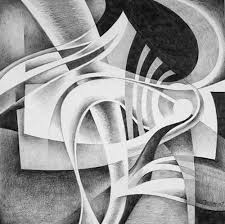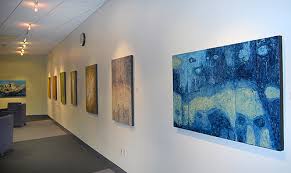Source:Google.com.pk
Abstract Pencil Drawings Biography
Art History: Abstract Art: (1910 - )
Abandoning the late 19th century European idea that art should imitate nature Abstract art does not strive to create accurate representations of any forms or objects. Artists employing the style take an object and either simplify or exaggerate it by altering its color shape and form. Abstract art developed before the twentieth century abstract patterns have roots in ancient history showing up in early decorations for textiles and pottery.
Abstraction reached its pinnacle as an accepted form of fine art in the twentieth century. Wassily Kandinsky was the original abstract artist producing the first completely abstract work of art in 1910. Two years later he wrote a theory on abstract art called On the Spiritual in Art. In this publication he emphasized the general theory among Abstract artists that art should portray the spiritual realm and not just the visual world. Abstract Art encompasses many different styles including Cubism, Neoplasticism, Expressionism, Futurism, Fauvism and Abstract Expressionism.
This site offers abstract art information, biographies of famous artists and original abstract art by Marten Jansen.
Although native cultures have always produced arts containing abstract elements, today's perception of abstract art dates back to 1910, when Pablo Picasso and Georges Braque invented cubism, which within half a decade, led to the pure abstract art created by Piet Mondrian and Russian styles such as constructivism and suprematism. While cubism and the styles that preceded it, such as post-impressionism, were partly based on native art that contained abstract elements (see for instance Picasso's black period), in cubism, for the first time in art history, artists began to paint abstract art as a result of a deliberate artistic and philosophical development. Halfway the 19th century philosophers had begun to doubt the sincerity and usefulness of classical art, with its emphasis on technique and its dependence of nature as a model to depict. At the same time the art of painting had reached a dead end in terms of inspiration and innovative thought. The impressionists were a fresh wind, but their emphasis on first impressions failed to convince men like Van Gogh, Gauguin and ultimately Picasso, who perceived impressionism as shallow and sought more powerful means of expression.
Abstract art timeline:
±1850 - 1907 : Philosophical debate puts into question the established values of classical art.
1905 - 1915 : Pablo Picasso and Georges Braques create cubism and Henri Matisse's fauvism serves as a bridge between post-impressionism and expressionism. Before the advent of cubism, Picasso's 1907 painting Les Demoisselles d'Avignon already inspires many artists to abstractism (Kandinsky, Léger).
1910 : First signs of pure abstract art: Kandinsky, Mondrian.
1912 - 1925 : Piet Mondrian and Russian abstract artists, led by Kasimir Malevich's suprematism and Vladimir Tatlin's constructivism, complete the creation of pure abstract art. Modigliani sets benchmark for abstract portraitism.
1925 - 1945 : Period characterised by geometric abstraction (De Stijl) and painterly automatism (Joan Miró).
1945 - 1960 : Painterly automatism becomes more radical in abstract expressionism and art informel, while some artists combine automatism with geometric abstraction (Rothko).
1960 - 1980 : Introduction of abstract art with design characteristics, as in Op Art, Pop Art and contemporary geometric abstraction.
1980 - NOW : Postmodernism - artistic inability to innovate or lack of social acceptance of innovation?
New Music Release........
"I´ve Got the Music Blaring", from Aug 20 on iTunes, Spotify and more
music blog rocking.mobi
The post-impressionists´ (such as Van Gogh and Gauguin) primary goal was to express their inner world and Gauguin would begin to paint from his imagination rather than to use nature as a model. Georges Braques had pioneered the technique of faceting an image, in order to capture the essence of an object, rather than the appearance, which would lead to cubism. While not able to reproduce the figurative function of Branques' technique of faceting, Picasso's way of faceting would become a stylistic means that led to almost pure abstraction, a process which would be completed by Mondrian and the Russian abstract artists.








Abstract Pencil Drawings Biography
Art History: Abstract Art: (1910 - )
Abandoning the late 19th century European idea that art should imitate nature Abstract art does not strive to create accurate representations of any forms or objects. Artists employing the style take an object and either simplify or exaggerate it by altering its color shape and form. Abstract art developed before the twentieth century abstract patterns have roots in ancient history showing up in early decorations for textiles and pottery.
Abstraction reached its pinnacle as an accepted form of fine art in the twentieth century. Wassily Kandinsky was the original abstract artist producing the first completely abstract work of art in 1910. Two years later he wrote a theory on abstract art called On the Spiritual in Art. In this publication he emphasized the general theory among Abstract artists that art should portray the spiritual realm and not just the visual world. Abstract Art encompasses many different styles including Cubism, Neoplasticism, Expressionism, Futurism, Fauvism and Abstract Expressionism.
This site offers abstract art information, biographies of famous artists and original abstract art by Marten Jansen.
Although native cultures have always produced arts containing abstract elements, today's perception of abstract art dates back to 1910, when Pablo Picasso and Georges Braque invented cubism, which within half a decade, led to the pure abstract art created by Piet Mondrian and Russian styles such as constructivism and suprematism. While cubism and the styles that preceded it, such as post-impressionism, were partly based on native art that contained abstract elements (see for instance Picasso's black period), in cubism, for the first time in art history, artists began to paint abstract art as a result of a deliberate artistic and philosophical development. Halfway the 19th century philosophers had begun to doubt the sincerity and usefulness of classical art, with its emphasis on technique and its dependence of nature as a model to depict. At the same time the art of painting had reached a dead end in terms of inspiration and innovative thought. The impressionists were a fresh wind, but their emphasis on first impressions failed to convince men like Van Gogh, Gauguin and ultimately Picasso, who perceived impressionism as shallow and sought more powerful means of expression.
Abstract art timeline:
±1850 - 1907 : Philosophical debate puts into question the established values of classical art.
1905 - 1915 : Pablo Picasso and Georges Braques create cubism and Henri Matisse's fauvism serves as a bridge between post-impressionism and expressionism. Before the advent of cubism, Picasso's 1907 painting Les Demoisselles d'Avignon already inspires many artists to abstractism (Kandinsky, Léger).
1910 : First signs of pure abstract art: Kandinsky, Mondrian.
1912 - 1925 : Piet Mondrian and Russian abstract artists, led by Kasimir Malevich's suprematism and Vladimir Tatlin's constructivism, complete the creation of pure abstract art. Modigliani sets benchmark for abstract portraitism.
1925 - 1945 : Period characterised by geometric abstraction (De Stijl) and painterly automatism (Joan Miró).
1945 - 1960 : Painterly automatism becomes more radical in abstract expressionism and art informel, while some artists combine automatism with geometric abstraction (Rothko).
1960 - 1980 : Introduction of abstract art with design characteristics, as in Op Art, Pop Art and contemporary geometric abstraction.
1980 - NOW : Postmodernism - artistic inability to innovate or lack of social acceptance of innovation?
New Music Release........
"I´ve Got the Music Blaring", from Aug 20 on iTunes, Spotify and more
music blog rocking.mobi
The post-impressionists´ (such as Van Gogh and Gauguin) primary goal was to express their inner world and Gauguin would begin to paint from his imagination rather than to use nature as a model. Georges Braques had pioneered the technique of faceting an image, in order to capture the essence of an object, rather than the appearance, which would lead to cubism. While not able to reproduce the figurative function of Branques' technique of faceting, Picasso's way of faceting would become a stylistic means that led to almost pure abstraction, a process which would be completed by Mondrian and the Russian abstract artists.
Abstract Pencil Drawings
Abstract Pencil Drawings
Abstract Pencil Drawings
Abstract Pencil Drawings
Abstract Pencil Drawings
Abstract Pencil Drawings
Abstract Pencil Drawings
Abstract Pencil Drawings
Abstract Pencil Drawings
Abstract Pencil Art
Abstract Pencil Drawings
No comments:
Post a Comment